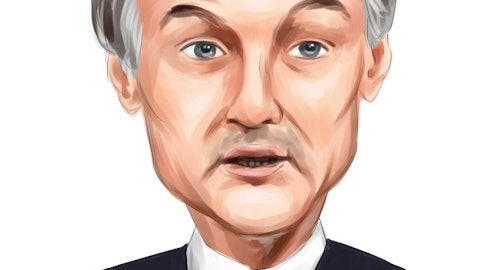Humacyte, Inc. (NASDAQ:HUMA) Q4 2023 Earnings Call Transcript March 22, 2024
Humacyte, Inc. isn’t one of the 30 most popular stocks among hedge funds at the end of the third quarter (see the details here).
Operator: Good morning, ladies and gentlemen, and welcome to the Humacyte 2023 Fourth Quarter Year-End Results Conference Call. Currently, all participants are in a listen-only mode. Later, we will conduct a question-and-answer session, and instructions will follow at that time. As a reminder, this conference call is being recorded. I will now turn the call over to Lauren Marek with LifeSci Advisors. Please go ahead.
Lauren Marek: Thank you, operator. Before we proceed with the call, I would like to remind everyone that certain statements made during this call are forward-looking statements under U.S. federal securities laws. These statements are subject to risks and uncertainties that could cause actual results to differ materially from historical experience or present expectations. Additional information concerning factors that could cause actual results to differ from statements made on this call is contained in our periodic reports filed with the SEC. The forward-looking statements made during this call speak only as of the date hereof, and the Company undertakes no obligation to update or revise the forward-looking statements, except as required by law.
Information presented on this call is contained in the press release we issued this morning and in our Form 10-K, which after filing may be accessed from the Investors page of the Humacyte website. Joining me on today’s call from Humacyte are Dr. Laura Niklason, President and Chief Executive Officer; Dale Sander, Chief Financial Officer and Chief Corporate Development Officer; and Dr. Heather Prichard, Chief Operating Officer. Dr. Niklason will provide a summary of the Company’s progress during the year and recent weeks, and Dale will review the Company’s financial results for the quarter and year ended December 31, 2023. Following their prepared remarks, the management team will be available for your questions. I will now turn the call over to Dr. Niklason.
Laura Niklason: Thank you, Lauren. Good morning, everyone, and thank you for joining us for our 2023 financial results and business update call. Our fourth quarter and the start of 2024 have been highly productive for Humacyte. Importantly, Humacyte completed submission of our BLA in December, and the FDA accepted our biologics license application for the HAV in the vascular trauma indication in February of this year. Over the course of 2023, we also made progress on our broader HAV pipeline, including the completion of enrollment of our Phase III trial in dialysis access, presentation and publication of clinical trial results in peripheral arterial disease and publication of preclinical results for our small caliber HAV in the juvenile heart model.
During today’s call, I’ll review these developments in more detail before turning the call over to Dale for a review of our financial results. Then we’ll be happy to open up the call to your questions. I’ll begin with our HAV program in vascular trauma. In December 2023, we submitted our BLA to the FDA. This was supported by a robust data package that included positive results from our V005 Phase II/III clinical trial. The BLA package also included real-world evidence from the treatment of wartime injuries in Ukraine under the humanitarian aid program that was supported by the FDA. Our data package showed that the HAV had higher rates of patency and lower rates of amputation and infection as compared to historic synthetic graft benchmarks. In the two trials combined, the 30-day patency or presence of blood flow for the HAV was 91.5% for extremity patients compared to 78.9% historically reported for synthetic grafts.
The HAV also demonstrated lower amputation rates with a rate of 4.5% as compared to 24.3% for synthetic grafts. And furthermore, the HAV had lower infection rates at 30 days, with a rate of 0.9% as compared to 8.4% historically for synthetic grafts. In other words, patients treated with the HAV were only 40% is likely to lose blood flow through their conduit after one month, which is a key period for recovery after traumatic injury. HAV patients were also only 1/5th is likely to suffer an amputation and only 1/9th is likely to have an infection of their graft as compared to patients who were treated with the synthetic graft. These results were also provided in November at multiple presentations at the VEITH Symposium, which is a major vascular surgery meeting held in New York.
In February of 2024, the FDA accepted our BLA and vascular trauma, also granting priority review and establishing a Prescription Drug User Fee Act, or PDUFA, goal date for action of August 10, 2024. The FDA’s decision to grant priority review aligns with their prior grant of a regenerative medicine advanced therapy or RMAT designation for the HAV for urgent arterial repair. We believe this also reflects their recognition that many patients with severe injuries are underserved by the current standards of care. Priority review is also consistent with the priority designation that was given by the Secretary of Defense under a law enacted to expedite the FDA’s review of products that are intended to diagnose, treat or prevent serious life-threatening conditions that are facing American military personnel.
The BLA acceptance brings us another step closer to our goal of providing an innovative regenerative medicine product for patients who are suffering traumatic vascular injury. Based on the strength of the data package, from our V005 trial in vascular trauma, combined with data from the humanitarian experience in Ukraine, we look forward to the PDUFA date with confidence. In preparation for an anticipated FDA approval, Humacyte is also working to build out the commercial team as part of our go-to-market strategy. Health economic models have been developed which are derived from large national databases of traumatic injury care in the U.S. Based upon historical results for synthetic graft outcomes, it’s clear that the HAV can provide important health benefits as well as important economic benefits for the healthcare system.
Cost of conduit infection, sepsis and amputation are extremely high adding tens or even hundreds of thousands of dollars to the cost of trauma care. Avoidance of these costly complications will, we believe, help to drive market uptake of this revolutionary product candidate in the care of traumatically injured patients. Turning now to our program in peripheral artery disease. In the fall, results were presented from an FDA-regulated and investigator-sponsored clinical study that’s being conducted at the Mayo Clinic of the HAV in patients with chronic limb-threatening ischemia, which is the end stage of PAD. Most patients treated as part of the program required bypass surgery below the knee, which is a type of disease that is typically not well treated with stents and angioplasty procedures.
Treated patients did not have suitable vein of their own to perform a needed bypass procedure. And so receive the HAV to revascularize their critically ischemic lower limbs. In presentations at the VEITH Symposium and at the Midwestern Vascular Conference, researchers observed that in the clinical study, the HAV was a safe, resilient and effective conduit for arterial bypass and limb salvage in patients who did not have vein to provide a conduit to restore blood flow. This is an important result since approximately 40% of patients requiring lower extremity bypass do not have saphenous vein available for revascularization. With regard to publications, in October of 2023, a publication in the Journal of Thoracic and Cardiovascular Surgery described a preclinical study showing the potential for the investigational small diameter HAV to treat Tetralogy of Fallot.

This is a heart condition that affects one in every 2,000 babies born in the U.S. each year. In this preclinical study, researchers from Nationwide Children’s Hospital in Columbus, Ohio, implanted 3.5 millimeter diameter HAVs into a juvenile large animal model of pediatric heart disease. In long-term follow-up in these animals, the 3.5-millimeter HAVs remained patent for up to six months and showed evidence of cellular repopulation by host cells, which is similar to what’s been observed in human patients. The pediatric heart study also demonstrated the extension of Humacyte’s manufacturing platform, adding the 3.5-millimeter vessels to the 6-millimeter vessels that have been manufactured for more than a decade. As a reminder, our 3.5-millimeter vessels are currently being evaluated in IND-enabling preclinical studies in large animals, to support future advancement of the HAV into human clinical trials in coronary artery bypass.
We’ve previously reported excellent long-term six-month results in coronary artery bypass in large animals. And cardiac implantations are continuing this year as we gather data in support of an IND filing in heart bypass surgery. In July, results of a preclinical study were also published in the Journal of Vascular Surgery-Vascular Science. This study provides a scientific basis for the low rates of infection that have been observed in our clinical trials of the HAV. Researchers found that compared to synthetic grafts, the HAV had a significantly lower bacterial infection rate. The infection resistance maybe due to the HAVs native-like tissue structure that supports superior compatibility with the body zone immune cells. These results have broad implications for all of our intended HAV indications and further support the HAVs potential as a solution to the limitations of synthetic grafts in a wide range of medical conditions.
And with that, I’ll now turn it over to Dale for a review of our financial results and other business development.
Dale Sander: Thank you, Laura. We had cash and cash equivalents of $80.4 million as of December 31, 2023. We also completed two transactions in early 2024, which added substantially to our cash balances. On March 5, 2024, we closed an underwritten public offering of common stock and raised net proceeds of approximately $43.1 million. In addition, on March 11, 2024, we’ve received $20 million in proceeds from an additional draw under our revenue purchase agreement with Oberland Capital. Total net cash used was $69.0 million for the year ended December 31, 2023, compared to $67.7 million for the year ended December 31, 2022. We believe that our cash and cash equivalents are adequate to finance operations well past the currently anticipated timelines for FDA approval and commercialization of the HAV in the vascular trauma indication.
There was no revenue for the fourth quarters of 2023 and 2022, and there were no revenue for the year ended December 31, 2023. Revenue was $1.6 million for the year ended December 31, 2022, and was related to a grant supporting the development of the HAV that was completed during 2022. Research and development expenses were $20.2 million for the fourth quarter of 2023 compared to $15 million for the fourth quarter of 2022, and were $76.6 million for the year ended December 31, 2023 compared to $63.3 million for the year ended December 31, 2022. The 2023 increases resulted primarily from increased personnel, external services expenses and materials expenses supporting the expanded research and development initiatives in our clinical studies, including the completion of our V005 Phase II/III trial, NRB017-Ukraine humanitarian trial for use of HAV and extremity vascular trauma as well as our BLA filing in December and the clinical development of the HAV for use in dialysis access.
General and administrative expenses were $6 million for the fourth quarter of 2023 compared to $5.8 million for the fourth quarter of 2022 and were $23.5 million for the year ended December 31, 2023, compared to $22.9 million for the year ended December 31, 2022. The 2023 slight net increases in G&A expenses resulted primarily from increased personnel costs, primarily driven by preparation of the planned commercial launch of HAV in the vascular trauma indication. Other net income or expense was net income of $1.1 million for the fourth quarter of 2023 compared to net income of $17.1 million for the fourth quarter of 2022 and was net expense of $10.7 million for the year ended December 31, 2023, compared to net income of $72.6 million for the year ended December 31, 2022.
The reduction in other net income in the fourth quarter of 2023 and the increase in other net expense for the year ended December 31, 2023, resulted primarily from the non-cash remeasurement of the contingent earn-out liability associated with the August 2021 merger with Alpha Healthcare Acquisition Corp. Net loss was $25.1 million for the fourth quarter of 2023 compared to $3.7 million for the fourth quarter of 2022. The net loss was $110.8 million for the year ended December 31, 2023 compared to $12 million for the year ended December 31, 2022. The 2023 increases in net loss resulted primarily from the non-cash remeasurement of the contingent earn-out liability and increased operating expenses, both described above. With that, I’ll turn it back to Laura for concluding remarks.
Laura Niklason: Thank you, Dale. This is a very exciting time for Humacyte and all of our stakeholders. I’d like to take a moment to thank the Humacyte team as well as our partners for their continued commitment to our programs. The entire team has worked incredibly hard to reach this point, and we are approaching what could be a transformational time not only for the company, but for patients suffering from a variety of vascular diseases and complications. Across our clinical programs, the HAV has already accumulated more than 1,200 patient years of experience, including in vascular trauma repair, dialysis access and peripheral artery disease. And we are continuing to study the HAV in our earlier programs in order to maximize the full potential of our technology platform and its value. We look forward to keeping you updated with our progress and thank you all for joining us today. Operator, we are ready to take questions.
Operator: Thank you. We will now be conducting a question-and-answer session. [Operator Instructions] Thank you. And our first question is from the line of Ryan Zimmerman with BTIG. Please proceed with your questions.
Ryan Zimmerman: Good morning. Can you hear me okay?
See also 15 Highest Paying Countries for Automotive Engineers and 10 Best Performing Energy Stocks Right Now.
Q&A Session
Follow Humacyte Inc.
Follow Humacyte Inc.
Laura Niklason: We can hear you.
Ryan Zimmerman: Good morning. Congrats on the progress. It’s so close. You can reach out and touch it. Maybe just to start, as we think about commercial preparation, Dale, you alluded to some of the health economic work you’re doing. I think one of the questions that investors have is kind of where the HAV lives economically in the spectrum of product offerings and kind of how you think about where you’d like it to be priced at? And to the extent that you can elaborate on kind of what the target opportunity looks like and the ramp that we should be thinking about as you prepare for commercial activity?
Dale Sander: Yes. Thanks, Ryan, and I’ll try to take those in somewhat order. But obviously, the HAV is the biologic, which has produced clinical results which are far superior to the comparable standard of care today, particularly synthetic grafts, it’s going to be priced at higher acquisition costs than the current standard of care. But we believe that our budget impact models, which are largely developed at this stage will show that due to the reduction in complications such as amputations and infections and in the case of saphenous vein reperfusion injury and other complications like that, that are very expensive for the providers. In this case, the hospitals that the overall cost of treating a patient with HAV will be very favorable.
And as you know, pricing itself is usually determined and announced at the time of launch because you don’t want to do that in a vacuum. You want to do that in combination with the clinical story and the health economic story. But I think as we’ve talked about in the past, if you look at our earliest SEC filings, we had suggested something in the $25,000 range for the product to be somewhat lower, could be somewhat higher, but wherever it falls within that range. Clearly, the health economic benefits that are going to be demonstrated due to this reduction of complications is going to be meaningful and certainly will support the pricing of the product. Beyond that, I think you had a question about market size. There’s around 80,000 vascular trauma cases each year within the United States.
And when we drill down and look very specifically at kind of the low-hanging fruit and the ones that are most immediately applicable to the HAV by looking at hospital billing codes and other information like that. There’s at least 26,000 cases, we believe, that are clear candidates for the HAV to be used within the United States, which suggest that this is a market that could be somewhere in the $600-plus million range dependent upon pricing. So hopefully, I’ve answered your questions, but point out that you can admit.
Ryan Zimmerman: No, no. Thank you, Dale. It’s still early. I know these are not fully flushed out. As you get closer, I think more clarity will emerge there. The other question is just around cash burn guidance. I think pro forma with the recent equity offering and some of the tranches from Oberland. I think you’re around the 140 range as of today, if I’m not mistaken, about 143, and that’s based on the gross proceeds from the recent equity offering. So I’m just curious what you can say for 2024 around cash burn, maybe any directional commentary on operating spend as you do kind of prepare for this commercial launch?
Dale Sander: Yes. Yes, certainly. I think your math is right. The way we look at it is we ended December 31 with a little more than – well, right around $81 million in cash. And when we add on the $63-plus million that we achieved through the equity financing as well as the additional draw into our Oberland facility. That means we’re entering the year with about $144 million in cash, which leaves us very well positioned. Our net cash burn for 2023 rounded to about $69 million. But if you back out the effect of some net financing transactions from an operating cash point of view and from a capital expenditure point of view, we’ve burned about $73.5 million in 2023 in those activities. So suggesting we’re very well positioned with the cash that we have on hand right now.
In terms of how we’ll proceed in the upcoming year, we haven’t given super specific guidance, but I’ll share what we’ve guided in the past is that certainly, we expect to expand our commercialization activities during the year, including near the time of launch, bringing on a relatively small sales force to address this very concentrated market. So we will have, obviously, higher commercialization expenses during this year. But we do also have a wind down of certain clinical costs during the year with the V005 study just in long-term follow-up and not as intensive activities as we had during 2023 as we prepared for the close out of that study and for filing of the BLA. And then also our dialysis trial [V007] will be winding down in the second half of the year, too.
So we expect somewhat of an increase in overall cash burn for the upcoming year, but not to a great extent on a net basis. And we believe that the cash on hand is certainly adequate to take us well past the commercial launches in trauma and AV access and well passed or certainly through 2026. So we certainly don’t have any cash concerns at this point in time.
Ryan Zimmerman: Very helpful, Dale. Thank you for all the information.
Operator: Our next question is from the line of Kristen Kluska with Cantor Fitzgerald. Please proceed with your question.
Kristen Kluska: Hi everyone. Good morning and congrats as well on the progress. I wanted to touch on manufacturing as this is often something that FDA scrutinizes on very closely during PDUFA and drug approval. So I wanted to ask how you’re feeling about your manufacturing? And also anything you’re doing to prepare for upcoming inspections and meetings that the FDA will be conducting?



